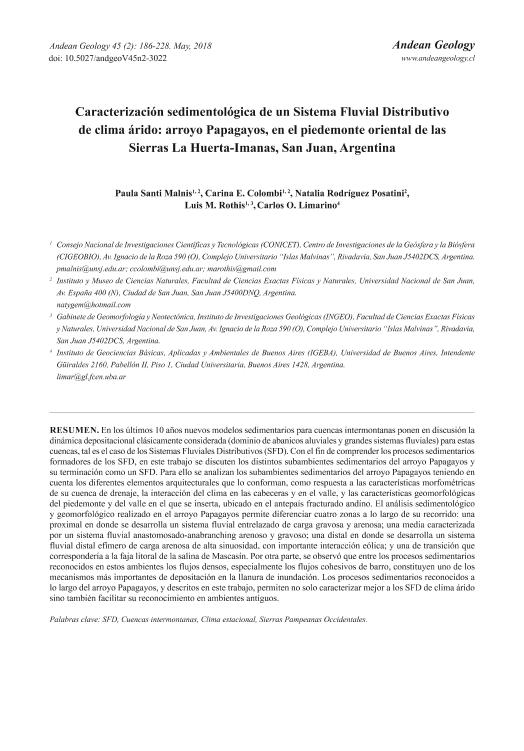Artículo
En los últimos 10 años nuevos modelos sedimentarios para cuencas intermontanas ponen en discusión ladinámica depositacional clásicamente considerada (dominio de abanicos aluviales y grandes sistemas fluviales) para estascuencas, tal es el caso de los Sistemas Fluviales Distributivos (SFD). Con el fin de comprender los procesos sedimentariosformadores de los SFD, en este trabajo se discuten los distintos subambientes sedimentarios del arroyo Papagayos ysu terminación como un SFD. Para ello se analizan los subambientes sedimentarios del arroyo Papagayos teniendo encuenta los diferentes elementos arquitecturales que lo conforman, como respuesta a las características morfométricasde su cuenca de drenaje, la interacción del clima en las cabeceras y en el valle, y las características geomorfológicasdel piedemonte y del valle en el que se inserta, ubicado en el antepaís fracturado andino. El análisis sedimentológicoy geomorfológico realizado en el arroyo Papagayos permite diferenciar cuatro zonas a lo largo de su recorrido: unaproximal en donde se desarrolla un sistema fluvial entrelazado de carga gravosa y arenosa; una media caracterizadapor un sistema fluvial anastomosado-anabranching arenoso y gravoso; una distal en donde se desarrolla un sistemafluvial distal efímero de carga arenosa de alta sinuosidad, con importante interacción eólica; y una de transición quecorrespondería a la faja litoral de la salina de Mascasín. Por otra parte, se observó que entre los procesos sedimentarios reconocidos en estos ambientes los flujos densos, especialmente los flujos cohesivos de barro, constituyen uno de losmecanismos más importantes de depositación en la llanura de inundación. Los procesos sedimentarios reconocidos a lo largo del arroyo Papagayos, y descritos en este trabajo, permiten no solo caracterizar mejor a los SFD de clima áridosino también facilitar su reconocimiento en ambientes antiguos. Recent studies proposed that distributive fluvial systems (DFS) occupy a great proportion in modern continental sedimentary basins, challenging classical sedimentary models proposed for similar ancient basin. Because of this, arises the importance of studying modern DFS with the aim of obtaining facial models to apply them in ancient deposits. In this paper, we analyze and discuss the sedimentary environments included in the modern deposits of the Arroyo Papagayos, Western Pampean Ranges, San Juan province, interpreted as a Distributive Fluvial System (DFS). We perform the study of the Papagayos creek by describing different architectural elements, which characterize the sub-environments organized in four zones from the mountain front to the distal playa lake. A low sinuosity gravelly-sandy bed braided fluvial system, characterizes the proximal zone. A medial to high sinuosity sandy-gravelly anastomosed-anabranching fluvial system describes the medial zone, where floodplain aggradation is domain by crevasse splays accretion. At this point, 10 km far from the mountain front, the deposits starts to develop a cone shaped morphology. A higher sinuosity flashy ephemeral meandering sandymuddy fluvial system with eolian interaction defines the distal zone, where the main channel of the system disappears by low gradient of the topography and infiltration depositing muddy terminal splays. Finally, eolian dune and wet interdune deposits characterizes the fourth zone, interpreted as a transitional area between the DFS and the saline playa lake. A particular feature observed along the DFS system is that mudflows are the main sedimentary process in the floodplain, probably as the result of the combination of the seasonal arid climate and the Arroyo Papagayos drainage basin morphometry and the low gradient of the topography. The sedimentary process and environments recognized along the Arroyo Papagayos will allow a better understanding of arid DFS depositional dynamics as well as, to identify them in the geological record. Lastly, high aggrading conditions for DFS development will response to climate interaction between upland catchment area (semiarid) and valley (arid), drainage basin morphometry, smooth piedmont gradient and high tectonic subsidence of the basin, located in the Andean broken foreland.
Caracterización sedimentológica de un Sistema Fluvial Distributivo de clima árido: arroyo Papagayos, en el piedemonte oriental de las Sierras La Huerta-Imanas, San Juan, Argentina
Título:
Sedimentological characterization of a distributive fluvial system of arid climates: Arroyo Papagayos, eastern piedmont of La Huerta-Las Imanas Ranges, San Juan, Argentina
Santi Malnis, Paula ; Colombi, Carina Ester
; Colombi, Carina Ester ; Rodríguez Posatini, Natalia; Rothis, Luis Martin
; Rodríguez Posatini, Natalia; Rothis, Luis Martin ; Limarino, Carlos Oscar
; Limarino, Carlos Oscar
 ; Colombi, Carina Ester
; Colombi, Carina Ester ; Rodríguez Posatini, Natalia; Rothis, Luis Martin
; Rodríguez Posatini, Natalia; Rothis, Luis Martin ; Limarino, Carlos Oscar
; Limarino, Carlos Oscar
Fecha de publicación:
05/2018
Editorial:
Servicio Nacional de Geología y Minería
Revista:
Andean Geology
ISSN:
0718-7092
e-ISSN:
0718-7106
Idioma:
Español
Tipo de recurso:
Artículo publicado
Clasificación temática:
Resumen
Palabras clave:
SFD
,
Cuencas Intermontanas
,
Clima estacional
,
Sierras Pampeanas
Archivos asociados
Licencia
Identificadores
Colecciones
Articulos(CCT - SAN JUAN)
Articulos de CENTRO CIENTIFICO TECNOLOGICO CONICET - SAN JUAN
Articulos de CENTRO CIENTIFICO TECNOLOGICO CONICET - SAN JUAN
Articulos(CIGEOBIO)
Articulos de CENTRO DE INVESTIGACIONES DE LA GEOSFERA Y BIOSFERA
Articulos de CENTRO DE INVESTIGACIONES DE LA GEOSFERA Y BIOSFERA
Articulos(IGEBA)
Articulos de INSTITUTO DE GEOCIENCIAS BASICAS, APLICADAS Y AMBIENTALES DE BS. AS
Articulos de INSTITUTO DE GEOCIENCIAS BASICAS, APLICADAS Y AMBIENTALES DE BS. AS
Citación
Santi Malnis, Paula; Colombi, Carina Ester; Rodríguez Posatini, Natalia; Rothis, Luis Martin; Limarino, Carlos Oscar; Caracterización sedimentológica de un Sistema Fluvial Distributivo de clima árido: arroyo Papagayos, en el piedemonte oriental de las Sierras La Huerta-Imanas, San Juan, Argentina; Servicio Nacional de Geología y Minería; Andean Geology; 45; 2; 5-2018; 186-228
Compartir
Altmétricas



